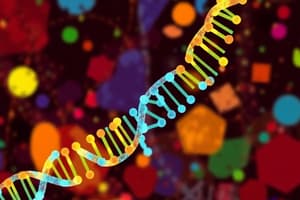Podcast
Questions and Answers
What is the primary role of the sigma factor in prokaryotic transcription?
What is the primary role of the sigma factor in prokaryotic transcription?
- It unwinds the DNA double helix during transcription.
- It modifies the RNA transcript after synthesis.
- It catalyzes the polymerization of RNA nucleotides.
- It assists RNA polymerase in locating the promotor sequence. (correct)
Which characteristic of the -10 sequence contributes to the initiation of transcription?
Which characteristic of the -10 sequence contributes to the initiation of transcription?
- It is located upstream of the transcription start site.
- It is rich in AT pairs, leading to weak hydrogen bonds. (correct)
- It contains a high concentration of GC pairs.
- It has strong hydrogen bonds between bases.
What happens immediately after RNA polymerase forms a closed complex with the DNA?
What happens immediately after RNA polymerase forms a closed complex with the DNA?
- The DNA strands are separated at the -10 sequence. (correct)
- The sigma factor dissociates from the holoenzyme.
- RNA polymerase synthesizes RNA in the closed complex.
- Transcription elongation begins.
Why do different prokaryotic genes have distinct -35 and -10 sequences?
Why do different prokaryotic genes have distinct -35 and -10 sequences?
What is the definition of the open complex in the context of prokaryotic transcription?
What is the definition of the open complex in the context of prokaryotic transcription?
What is the significance of point mutations at the lac promoter?
What is the significance of point mutations at the lac promoter?
During the transition from initiation to elongation, what defines promoter clearance?
During the transition from initiation to elongation, what defines promoter clearance?
What is the composition of the RNA polymerase core in prokaryotic cells?
What is the composition of the RNA polymerase core in prokaryotic cells?
What is abortive initiation in RNA transcription?
What is abortive initiation in RNA transcription?
What is the role of the sigma factor during transcription?
What is the role of the sigma factor during transcription?
What characterizes Rho independent termination of transcription?
What characterizes Rho independent termination of transcription?
Which of the following is a function of RNA polymerase I in eukaryotic cells?
Which of the following is a function of RNA polymerase I in eukaryotic cells?
Which statement regarding eukaryotic transcription is correct?
Which statement regarding eukaryotic transcription is correct?
What distinguishes general transcription factors from regulatory transcription factors?
What distinguishes general transcription factors from regulatory transcription factors?
How do prokaryotic and eukaryotic cells differ in RNA polymerase usage?
How do prokaryotic and eukaryotic cells differ in RNA polymerase usage?
What is the role of Rho protein in Rho dependent termination?
What is the role of Rho protein in Rho dependent termination?
What is the primary role of TFIID in transcription?
What is the primary role of TFIID in transcription?
Which general transcription factor is involved in stabilizing TFIIB and RNA polymerase II interactions?
Which general transcription factor is involved in stabilizing TFIIB and RNA polymerase II interactions?
Which factor is necessary for transitioning from the preinitiation complex to the initiation complex?
Which factor is necessary for transitioning from the preinitiation complex to the initiation complex?
What key event triggers RNA polymerase II to move from initiation to elongation during transcription?
What key event triggers RNA polymerase II to move from initiation to elongation during transcription?
Which part of TFIID binds to the TATA box?
Which part of TFIID binds to the TATA box?
What role does the mediator play during eukaryotic transcription?
What role does the mediator play during eukaryotic transcription?
What does TFIIH do during the initiation of transcription?
What does TFIIH do during the initiation of transcription?
Which general transcription factor helps to recruit RNA polymerase II to the promoter?
Which general transcription factor helps to recruit RNA polymerase II to the promoter?
What is the primary role of the 5’ cap added to RNA during transcription?
What is the primary role of the 5’ cap added to RNA during transcription?
Which enzyme is responsible for adding GMP to the 5’ end of RNA during the capping process?
Which enzyme is responsible for adding GMP to the 5’ end of RNA during the capping process?
What type of bond is formed between the 5’ cap and the mRNA strand?
What type of bond is formed between the 5’ cap and the mRNA strand?
What initiates the process of 3’ polyadenylation in an RNA strand?
What initiates the process of 3’ polyadenylation in an RNA strand?
Which enzyme is responsible for adding repeated adenines during 3’ polyadenylation?
Which enzyme is responsible for adding repeated adenines during 3’ polyadenylation?
What is one of the main functions of the poly-A tail added at the 3’ end of RNA?
What is one of the main functions of the poly-A tail added at the 3’ end of RNA?
How many nucleotides are typically synthesized before the 5’ cap is added to the RNA strand?
How many nucleotides are typically synthesized before the 5’ cap is added to the RNA strand?
What is the role of polyA binding proteins in relation to the poly-A tail?
What is the role of polyA binding proteins in relation to the poly-A tail?
What is the primary function of RNA splicing?
What is the primary function of RNA splicing?
Which part of the pre-RNA transcript is typically removed during transcription?
Which part of the pre-RNA transcript is typically removed during transcription?
What is the role of small nuclear ribonucleoproteins (snRNPs) in RNA processing?
What is the role of small nuclear ribonucleoproteins (snRNPs) in RNA processing?
Which consensus sequence is located at the 5’ splice site of an intron?
Which consensus sequence is located at the 5’ splice site of an intron?
What happens during the formation of the lariat structure in RNA splicing?
What happens during the formation of the lariat structure in RNA splicing?
Which of the following statements is true regarding introns?
Which of the following statements is true regarding introns?
How many splice sites are typically associated with a single intron?
How many splice sites are typically associated with a single intron?
During RNA processing, what occurs just before the addition of the 3' poly-A tail?
During RNA processing, what occurs just before the addition of the 3' poly-A tail?
Flashcards are hidden until you start studying
Study Notes
Prokaryotic Transcription
- Sigma factor is a subunit of RNA polymerase that binds to the core enzyme, forming the holoenzyme.
- RNA polymerase holoenzyme can bind to DNA, specifically to the promoter sequence.
- Promoter sequences include the -35 and -10 sequences, recognized by the sigma factor.
- -10 sequence is AT-rich, allowing for DNA strand separation to form an open complex.
- Different genes have different -35 and -10 sequences due to the use of different sigma factors.
- Point mutations in the promoter sequence can increase gene expression if they are similar to the consensus sequence.
Initiation of Transcription
- RNA polymerase core is a heteropentamer consisting of 5 subunits.
- Sigma factor binds to the core, forming the RNA polymerase holoenzyme.
- Holoenzyme scans DNA for the -35 and -10 sequences, forming a closed complex.
- DNA strand separation at the -10 sequence creates an open complex.
- Abortive initiation occurs when RNA polymerase binds and unbinds repeatedly due to a lack of primers, leading to unstable binding at the template.
Elongation of Transcription
- Promoter clearance occurs after RNA synthesis begins and RNA polymerase leaves the promoter.
- Sigma factor is released and recycled.
- Transcription termination can occur through two mechanisms:
- Rho-independent termination: relies on RNA secondary structure and adenine repeats to form a hairpin loop.
- Rho-dependent termination: relies on the Rho protein binding to a specific site and separating the RNA from the template.
Eukaryotic Transcription
- Eukaryotic transcription is similar to prokaryotic transcription but with several differences:
- Multiple RNA polymerases: eukaryotes have three RNA polymerases (I, II, and III) compared to one in prokaryotes.
- More regulatory sequences: eukaryotes have more complex regulatory sequences.
- Nucleosomes: eukaryotes have nucleosomes that can influence transcription.
- Transcription factors: eukaryotes require more proteins for initiation.
Transcription Factors
- Transcription factors bind to promoters and affect transcription rates.
- General transcription factors (GTFs): essential for transcription and include TFIID, TFIIB, TFIIF, TFIIE, and TFIIH.
- Regulatory transcription factors: influence transcription rates and include activators and repressors.
Eukaryotic Transcription Initiation Complex
- TFIID: binds to the TATA box via TBP and TAF subunits, bending DNA and recruiting TFIIB.
- TFIIB: helps recruit RNA polymerase II and binds TBP and BRE.
- TFIIF: binds RNA polymerase II and stabilizes TFIIB-pol II interactions.
- TFIIE: recruits TFIIH.
- TFIIH: facilitates initiation to elongation transition through helicase and kinase activity.
Transition from Initiation to Elongation
- Preinitiation complex: formed by five GTFs and the core promoter.
- Initiation complex: formed after TFIIH performs its functions.
- TFIIH triggers the transition by phosphorylating the CTD of RNA Polymerase II, resulting in release of TFIIB, TFIIE, and TFIIH.
Mediator
- Mediator facilitates long-range interactions between regulatory sequences and the promoter region.
- Mediator is located on the tail of RNA polymerase II after phosphorylation by TFIIH.
RNA Processing
- 5' cap: a modified guanine base at the 5' end of RNA that protects the RNA from degradation and facilitates translation, nuclear transport, and splicing.
- 5' cap addition: involves three enzymes:
- RTPase: removes a phosphate from the 5' end.
- GTase: adds GMP to the 5' end.
- Guanylyl-7-methyltransferase: adds a methyl group to create 7-methyl-guanosine.
3' Polyadenylation
- 3' polyadenylation: adds a poly-A tail to the 3' end of RNA that protects the RNA from degradation and serves as a binding site for proteins.
- Polyadenylation process:
- Polyadenylation signal (AAUAAA): recognized by poly-A binding proteins.
- Endonuclease: cleaves after the signal sequence.
- Polyadenylated polymerase (PAP): adds adenine repeats.
- Poly-A binding proteins: bind to the adenine repeats and protect the 3' end.
RNA Splicing
- RNA splicing: removal of introns and exons from the primary RNA transcript.
- Introns: non-coding sequences within genes.
- Exons: coding sequences within genes.
Spliceosome
- snRNPs (small nuclear ribonucleoproteins): RNA-protein complexes involved in splicing.
- snRNAs: RNA component of snRNPs that help identify splice site sequences.
- Spliceosome: complex formed by snRNPs that catalyzes splicing.
- Splice sites: regions within pre-RNA transcripts where splicing occurs.
Splicing Process
- 5' splice site: GU
- Branch point: an A near the 3' end.
- 3' splice site: AG
- Lariat formation: 2'-OH of the branch point A attacks the phosphate at the 5' splice site, forming a loop.
- Intron removal: the lariat is removed.
- Exon joining: two exons are joined together.
Studying That Suits You
Use AI to generate personalized quizzes and flashcards to suit your learning preferences.




